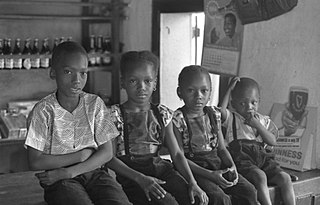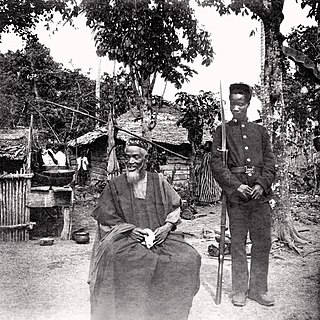
Sierra Leone, officially the Republic of Sierra Leone, is a country on the southwest coast of West Africa. It is bordered to the southeast by Liberia and by Guinea to the north. Its land area is 71,740 km2 (27,699 sq mi). It has a tropical climate and environments ranging from savannas to rainforests. As of the 2015 census, Sierra Leone had a population of 7,092,113. Freetown is both its capital and its largest city. The country is divided into five administrative regions, which are further subdivided into 16 districts.
Sierra Leone first became inhabited by indigenous African peoples at least 2,500 years ago. The Limba were the first tribe known to inhabit Sierra Leone. The dense tropical rainforest partially isolated the region from other West African cultures, and it became a refuge for peoples escaping violence and jihads. Sierra Leone was named by Portuguese explorer Pedro de Sintra, who mapped the region in 1462. The Freetown estuary provided a good natural harbour for ships to shelter and replenish drinking water, and gained more international attention as coastal and trans-Atlantic trade supplanted trans-Saharan trade.

Freetown is the capital and largest city of Sierra Leone. It is a major port city on the Atlantic Ocean and is located in the Western Area of the country. Freetown is Sierra Leone's major urban, economic, financial, cultural, educational and political centre, as it is the seat of the Government of Sierra Leone. The population of Freetown was 1,347,559 as of the 2024 census.
Pepel is a coastal town in the Port Loko District in the Northern Province of Sierra Leone.

Bombali is a district in the Northern Province of Sierra Leone. Its capital and largest city is Makeni, which is also the largest city in the north. The Bombali district is one of the sixteen districts of Sierra Leone. Bombali is one of the largest districts in Sierra Leone by geographical area, after Koinadugu District, and is the second most populous district in the Northern part of Sierra Leone, after Port Loko district. In the 2015 Sierra Leone national census, the population of Bombali District was 606,183. Other major towns in Bombali District include Kamabai, Karina and Binkolo.
Port Loko is the capital of Port Loko District and since 2017 the North West Province of Sierra Leone. The city had a population of 21,961 in the 2004 census and current estimate of 44,900. Port Loko lies approximately 57 km (35 mi) north-east of Freetown. The area in and around Port Loko is a major bauxite mining and trade centre. The town lies on the main highway linking Freetown to Guinea's capital Conakry. It also lies on the over-land highway between Freetown and its major airport, Lungi International Airport, although most travellers complete this journey via the much shorter ferry or helicopter transit.

Ernest Bai Koroma is a Sierra Leonean politician who served as the fourth President of Sierra Leone from 17 September 2007 to 4 April 2018.

The Temne, also called Atemne, Témené, Temné, Téminè, Temeni, Thaimne, Themne, Thimni, Timené, Timné, Timmani, or Timni, are a West African ethnic group. They are predominantly found in the Northern Province of Sierra Leone. Some Temne are also found in Guinea. The Temne constitute the largest ethnic group in Sierra Leone, at 35.5% of the total population, which is slightly bigger than the Mende people at 31.2%. They speak Temne, which belongs to the Mel branch of the Niger–Congo languages.

Port Loko District is a district in the North West Province of Sierra Leone. It is the most populous district in the North and the second most populous district in Sierra Leone, after Western Area Urban District. As of the 2015 census, Port Loko District has a population of 614,063. The district capital is the town of Port Loko and its largest city is Lunsar. The other major towns in the district include Masiaka, Rokupr, Pepel, Lungi and Gbinti.

The Western Area Rural District is one of the sixteen districts of Sierra Leone. It is located mostly around the peninsula in the Western Area of Sierra Leone. The Western Area Rural District has a 2015 census population of 442,951. The district capital and largest city is Waterloo. Other major towns in the district include Newton, Benguema, Leicester, Tombo and Regent. Most of the towns and villages in the Western Area Rural District are close to the capital Freetown and are part of the Freetown Metropolitan Area.

Bai Bureh was a Sierra Leonean ruler, military strategist, and Muslim cleric, who led the Temne and Loko uprising against British rule in 1898 in Northern Sierra Leone.
Lungi is a coastal town in Port Loko District in the Northern Province of Sierra Leone. The town lies approximately 40 miles (64 km) north of the district capital Port Loko and had a population of 4,185 in the 2004 census.
Waterloo is a city in the Western Area of Sierra Leone and the capital of the Western Area Rural District, which is one of the sixteen districts of Sierra Leone. Waterloo is located about twenty miles east of Freetown. Waterloo is the second largest city in the Western Area region of Sierra Leone, after Freetown. The city had a population of 34,079 in the 2004 census, and 55,000 as per a 2015 estimate. Waterloo is part of the Freetown metropolitan area.
Lunsar is a town in Marampa Chiefdom, Port Loko District in the Northern Province of Sierra Leone. It is the largest town in Port Loko District by population. The Britannica estimate of the population of Lunsar is 36,108. The town is one of the main commercial and business hub in the North of Sierra Leone. Lunsar lies approximately 50 miles east of Freetown and about 18 miles south-east of the district capital of Port Loko. The inhabitants of Lunsar are largely from the Temne ethnic group.
Jamaican Maroons descend from Africans who freed themselves from slavery in the Colony of Jamaica and established communities of free black people in the island's mountainous interior, primarily in the eastern parishes. Africans who were enslaved during Spanish rule over Jamaica (1493–1655) may have been the first to develop such refugee communities.

The Loko are one of the indigenous ethnic groups in Sierra Leone. Landogo is used as an endonym for the people and language, but other groups refer to them as Loko. They speak a Southwestern Mande language that is also called Loko. The majority of the Loko people live in the Northern Province of the country, particularly in Bombali District, and around the capital city of Freetown in communities such as Regent. Important regional towns include Tambiama, Kalangba, Kagbere, Batkanu, and Gbendembu, though other groups such as the Mandingo, Fula and Temne peoples live there too.
Gbinti is a rural town in Dibia chiefdom, Port Loko District in the Northern Province of Sierra Leone. The town is the chieftaincy seat of Dibia chiefdom. Gbinti lies about 20 miles from the district capital Port Loko and approximately 52 miles east of Freetown.
Kalangba (/kælæŋbæ/)(Loko: Ngangba) is a rural village in Bombali District, Northern Province, Sierra Leone. It is the headquarters for Ngowahun Chiefdom. It is situated about 15 miles (24 km) northwest of Makeni, the largest city in Sierra Leone's northern region. Kalangba is approximately 134 miles (216 km) north-east of the nation's capital, Freetown. It is a multicultural community. The majority of the inhabitants belong to the Loko ethnic group as well as the Fula and Mandingo. The Loko are the fifth largest ethnic group in Sierra Leone. As of the 2016 census, the population was 3,000.

Sierra Leone is officially a secular state, although Islam and Christianity are the two main and dominant religions in the country. The Sierra Leone Government is constitutionally forbidden from establishing a state religion, though Muslim and Christian prayers are usually held in the country at the beginning of major political occasions, including presidential inauguration.

Sierra Leone is home to about sixteen ethnic groups, each with its own language. In Sierra Leone, membership of an ethnic group often overlaps with a shared religious identity. According to the 2004 census Temne is the largest ethnic group in Sierra Leone.











